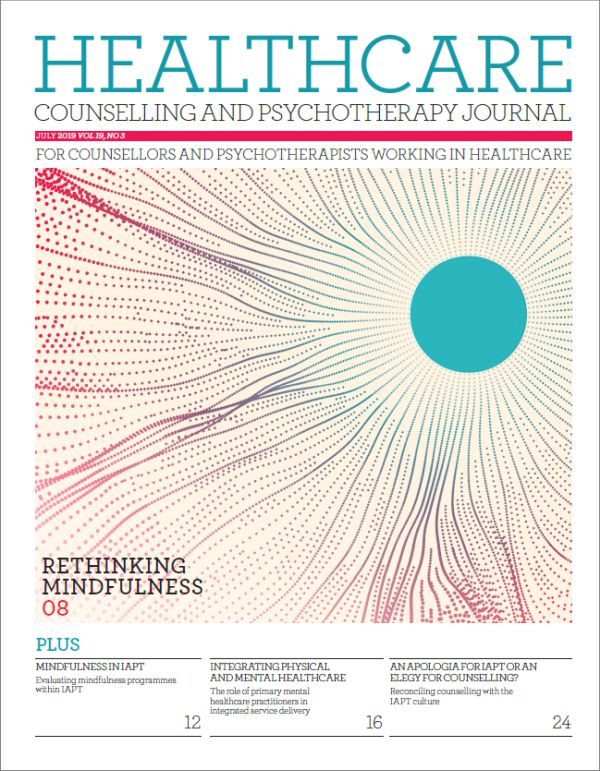In this issue
Features
Mindfulness and equanimity in the NHS and voluntary sector (free article)
Joey Weber challenges us to consider some of the misperceptions of practising mindfulness
Adapting mindfulness in an IAPT service
Christine Bowles reports on an evaluation of a mindfulness programme for individuals experiencing stress, anxiety, depression and long-term health conditions
Primary care mental health practitioners: integrating physical and mental healthcare
Dr Phil Anderson describes an innovative model of integrated service delivery
An apologia for IAPT or an elegy for counselling?
Toby Swift considers how counselling can be reconciled with the IAPT culture
Regulars
Chair’s report – BACP healthcare
Satinder Panesar
Healthcare update
Judy Stafford
Profile
Angela Clarke
Counselling in primary care
Elaine Davies

Divisional members and subscribers can download a pdf of this issue from the Healthcare Counselling and Psychotherapy Journal archive.
From the editor
It often feels to me as though mindfulness is the buzzword of the moment in mental healthcare. Many of us may encourage our clients to explore mindfulness and we may exalt its benefits for a whole range of mental health difficulties, such as depression and anxiety. And yet, I suspect many of us are guilty of not necessarily employing it in our own lives or in our moment-by-moment interactions with our clients.
In our lead article, Joey Weber helps us to rethink how we can use mindfulness in our work as therapists. He challenges us to address excuses, such as ‘I’m too busy’ or ‘I have to multitask’, and helps us to see that these need not be obstacles to practising mindfulness. He shows us how mindfulness is not just about meditation, but rather can be practised in everyday life, by giving our full attention to what we are doing at the time, be that simply breathing or being fully present with a client. He notes how mindfulness and equanimity can help to increase our compassion to all our clients.
If we are to successfully work mindfully with our clients, and teach them in turn to be mindful, we need to have a way of measuring outcomes. Christine Bowles reports on an evaluation of two mindfulness programmes within IAPT for individuals experiencing stress, anxiety, depression and long-term health conditions. The eight-week programmes accept referrals from therapists, healthcare practitioners and self-referrals. Participants were asked to evaluate the programmes six months after completing them. I found it encouraging to read that most of the respondents were continuing to practise mindfulness in some form; the majority had also experienced a decrease in their symptoms of depression or anxiety. It seems to me that this is a good example of how we can evaluate and measure the impact of our therapeutic interventions in a relatively simple and straightforward way.
It is only by evaluating and measuring impact that we can begin to innovate and implement meaningful change. Phil Anderson writes about another NHS trust’s innovative scheme that sees the creation of a new mental health role: primary care mental health practitioners (PCMHP). The aim of the PCMHP role is to manage the gap in services between primary and secondary mental healthcare. Too many people seem to fall through this gap, not meeting the criteria for referral into secondary care, yet having needs that are too complex to be met by the very limited resources available in primary care settings. Phil highlights how the burden of care often therefore falls on family and friends. The PCMHPs liaise directly with the individual and their carers in the community, as well as providing teaching, training and support on mental healthcare to primary care service providers. Primary care staff involved in the initiative have indicated that this has helped to improve their understanding of mental health issues and of the needs of their patients. Initiatives like this seem to me to be essential in an environment in which both primary and secondary mental healthcare are full to capacity.
In the April issue of this journal, we published an article on the experiences of some counsellors working in IAPT. This detailed the struggles that they experienced in reconciling their modality of working with the IAPT culture, which is often criticised for its focus on targets and performance measures. In this issue, Toby Sweet provides an alternative perspective, emphasising that, whatever our modality, it is right and proper that we ensure that clients are seen as quickly as possible and that we are working as efficiently as possible. We have to, of course, ensure that the means by which this is achieved are proportionate and do not detract from offering the best possible therapeutic support to our clients. The debate on the ‘fit’ of IAPT with different therapeutic modalities will be one that continues for as long as IAPT exists; we must ensure that our discussions do not lose sight of the important contribution made by colleagues of all modalities, be they CBT, person-centred or psychodynamic practitioners.
Finally, I would like to use this opportunity to announce that I will be stepping down as editor of this journal in October, and BACP will therefore be looking for someone to replace me. If you believe that you have the background, skills and ability to take on this interesting role, please do look out for the advertisement that will appear on the BACP website shortly. Do feel free to contact me if you would like to have an informal chat about the role.
Joanna Benfield, Editor
hcpj.editorial@bacp.co.uk
